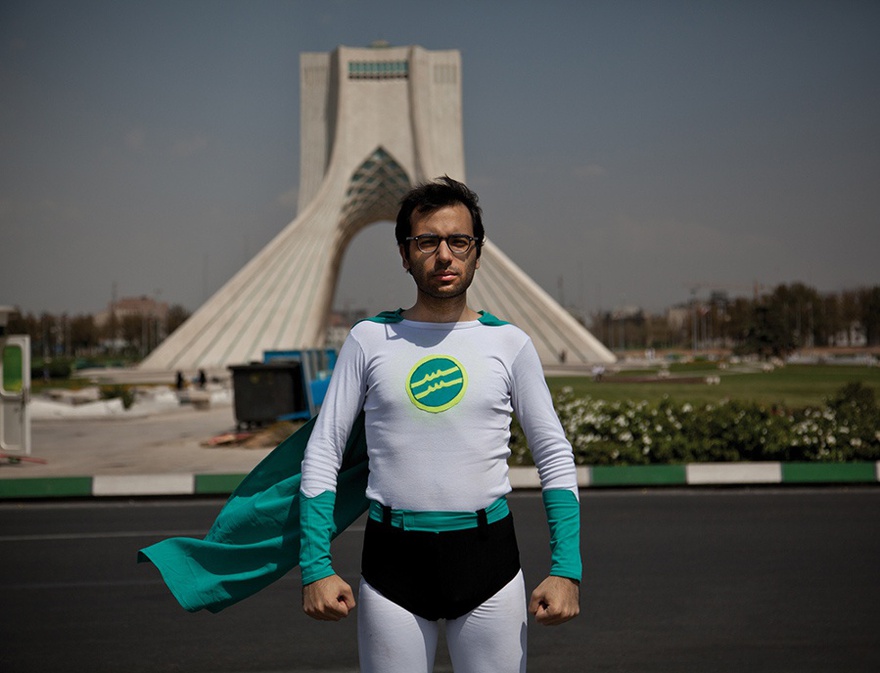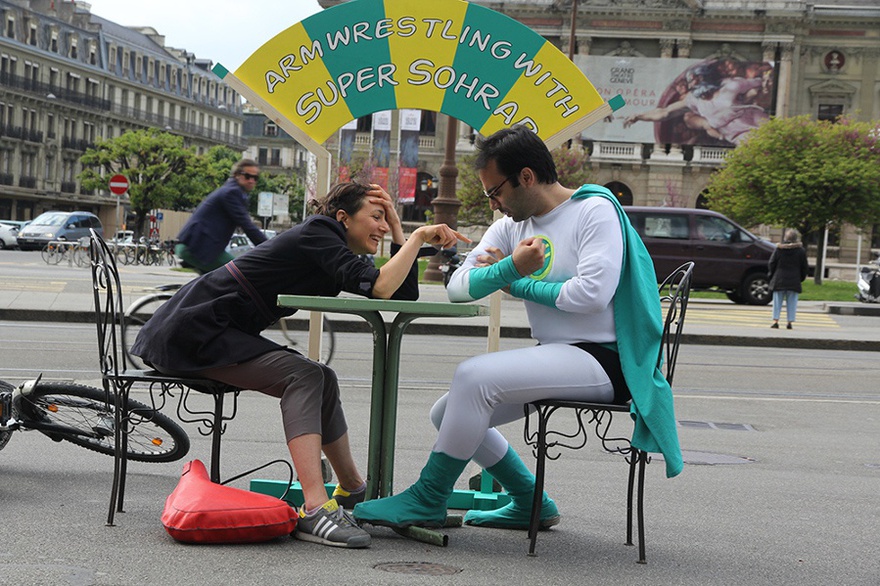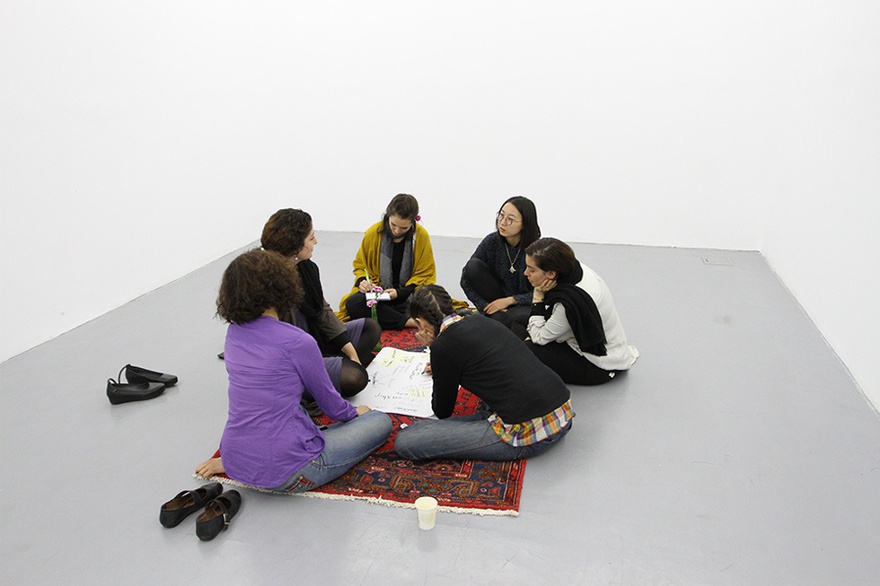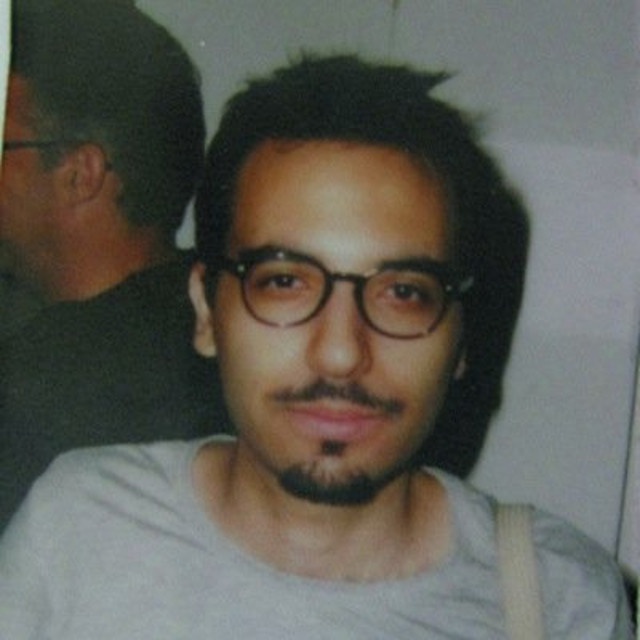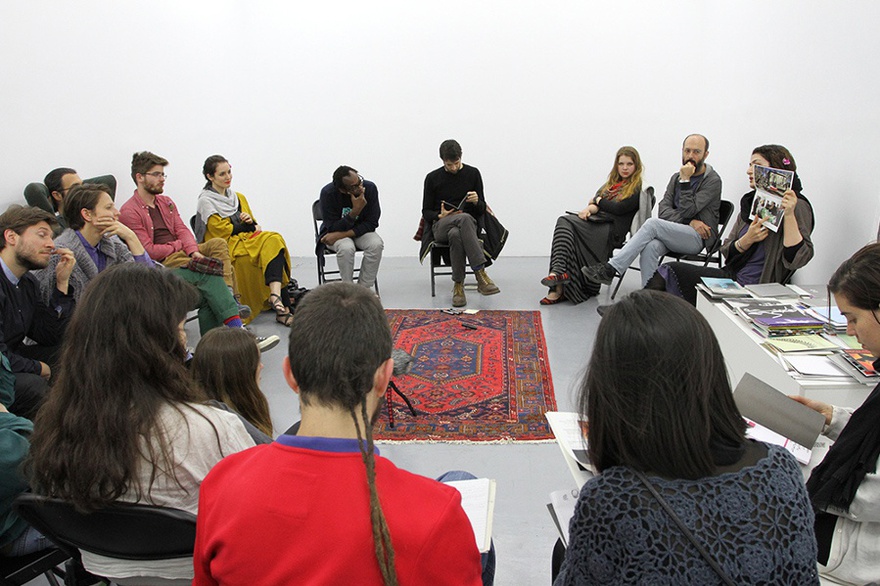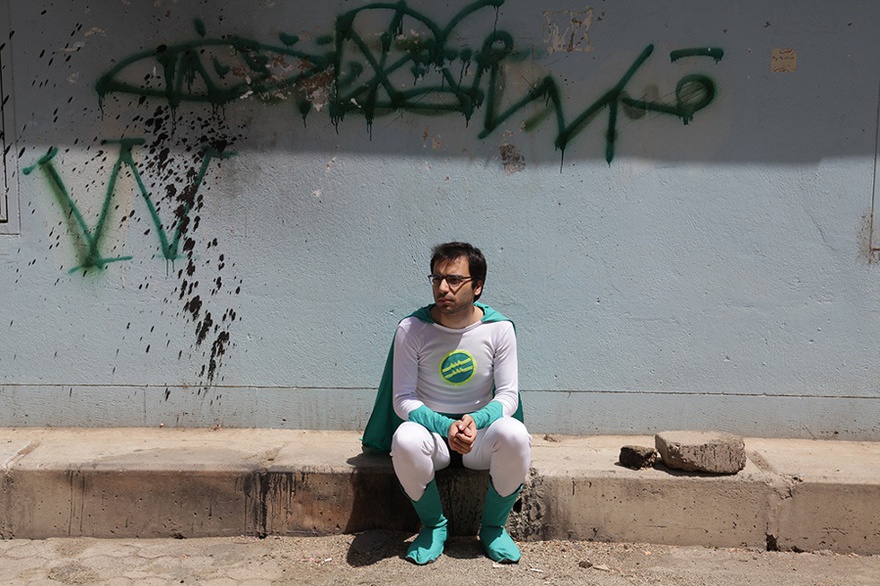Interviews
Hero to Hero
Sohrab Kashani in conversation with Taus Makhacheva
Super Sohrab is the alter-ego of Sohrab Kashani, an interdisciplinary artist and independent curator, and the founding director of artist collective and former non-profit art space, Sazmnanab, whose activities include projects include producing events, talks and artist and curator residencies. Super Sohrab emerged in 2009 as a response to the collective sadness felt after the 2009 Iranian Green Movement, which erupted in protest of the presidential election of Mahmoud Ahmadinejad. Super Sohrab's practice focuses on failure, and is driven by the need to fix local and global problems while documenting the process through film, video, comic and text. In truth, he has admitted that he "doesn't do many impressive things" – "He washes the dishes, makes pasta, does the laundry, checks his Facebook profile…" Various interventions include Arm Wrestling with Super Sohrab, for which Super Sohrab arm-wrestled some fifty Geneva residents passing by a busy street in Geneva, one of the many performances that inspired artist Taus Makhacheva to create her own alter-ego, Super Taus, in homage to her superhero mentor. In this interview, the two artists move between their personas, exploring what it means to be a failed superhero in the 21st Century.
Super Taus (ST): Hello Super Sohrab!
Super Sohrab (SS): Hello Super Taus! Nice to meet you!
ST: (whispering) I think we have met before. How is it going?
SS: Good! I've been busy. Being a superhero is a part-time job. I also do other things.
ST: Like what?
SS: I am also the director and curator of a non-profit art space in Tehran, 'Sazmanab'.
ST: Oh really? I did not know that! That's very interesting! Is that when you become Sohrab Kashani? When you are directing Sazmanab?
Sohrab Kashani: Well, sometimes the two personalities complete each other. It's not always a complete different personality, but part of the same personality. They share most details. What happens with Super Sohrab is a document of my own life. My misfortunes become the stories that comprise the comics. So it is the mixture of the two. I don't think it is any different; I have never done it differently.
Taus Makhacheva: How do you know when to switch from Sohrab Kashani to Super Sohrab?
SK: I guess it all starts when something is wrong; or when something unfortunate happens to me. That's when Super Sohrab takes over. But when I say he takes over it doesn't mean that he takes over me completely. He just records, observes and – in his own way – tries to help resolve the situation. In the end he usually fails and his failure is, at times, documented.
TM: So basically he appears in order for Sohrab Kashani not to fail?
SK: More to record or observe the failure. Not to stop it.
TM: Now it's getting really analytical! How did it all start? How did Super Sohrab appear in your life?
SK: It was back in 2009, during the uprisings in Tehran. It is a byproduct of those times and also of other personal reasons. Like my own lifestyle: how I used to live then, and how I live now. At that time, Sazmanab, my studio, and my home were all one and the same. I wasn't going out much. I hardly ever left home. It took me an entire week to leave the apartment, go to the supermarket, and buy the next week's supplies. I didn't have any windows at the old apartment; I didn't know what time it was. I used to just sleep and wake up: one time at 5 pm, one time at 5 am. It was a little bit chaotic. At that specific time, everyone was just so sad. This was something that came out to help me take control.
Super Sohrab was first documented on video. It was not a performance, though, but rather a video representation of what my life was like in 2009. This was after the Green movement protests failed and there was an epidemic of sadness going on in Tehran. The project later included comics, and I started recording what was happening to me and affecting me directly: with visa complications, travel, and sanctions. It became a platform, with which I could have a voice and make a stand. Super Sohrab is generally featured in the international sections, and not always in the art sections, of newspapers. Sometimes I do interviews as Super Sohrab, for which I am more direct. The interviews, videos, comics and the performances are all part of it. The things I do in parks, which I usually do not document, are part of it. For example Arm Wrestling with Super Sohrab happens often but generally is not documented, and if it ever is, the personal conversations with my opponents are never recorded.
TM: I completely understand. For me, Super Taus was the only mode of resistance from what was happening in Russia, with Ukraine, and with the flow of media, which is completely impossible to follow anymore. I am not sure which side is telling the truth about the situation. It also was the invisibility of female labour in the region, and the pressure this causes. It is the same, somehow, how Super Sohrab emerged, and how Super Taus was created. In these moments of complete sadness and darkness, there is a certain longing for a united world, and for a superhero to appear who might be able to make that a reality. It is the only way not to fail: to fail publicly and through this failure talk about what is going on. Because you fail constantly in your life in some way, right?
SK: You are on the same track.
ST: What I find interesting is that, well, I have superpowers. I am super strong, but most of the things I do are invisible. I have one video of me clearing a road from a large boulder that is documented accidentally by a dashboard camera that was installed in my car for safety reasons. So I wonder about failure. How does it help, how does it work, and how is it different now, compared to when Super Sohrab appeared in those times of darkness?
Taus Makhacheva
SuperTaus, 2014
2 mins 16 secs
SK: Super Sohrab's personality derives from my own personality. There is a direct link to my own personality, to how I am and how I feel. As time goes by and as I age, he also changes through time. That is why it is an ongoing project, which I don't think will ever end. Maybe it will not be visible at certain times, but it will be there. We are growing together, therefore the two identities are not separate. There is this soothing feeling that comes from acknowledging failure. When you acknowledge the failure and move past it, you may be able to accomplish something. That is how it works for me.
Another part of it is the call for help. The Super Sohrab website is down at the moment, but normally it works and you can send me a call for help. I receive texts, emails, and applications from people who ask for my help. I review them carefully. Last year I received a call for help from Atefeh, an Iranian graduate student who was studying Cinema in Geneva. All the students in her class received proper funding from her university to make their dissertation films, but she was not able receive hers. The university refused to pay her and everyone else involved with her film because of the embargo and sanctions on Iran. I went to Geneva as Super Sohrab and had meetings with the university administration and the school headmaster. They denied this rejection of funding had anything to do with the sanctions on Iran, and blamed it all on Atefeh. So we started making inquiries and we spoke with graduate students from Geneva who had went through the same ordeal, lawyers, bank employees and different student organizations.
All of this became part of Atefeh's new film, which she made from scratch instead of the film she had plans to make in the beginning. The film is not my work. It became a joint collaboration. The documentation is never my work; it is just something that is made by others. And even if I do it, it is Sohrab Kashani doing it and not Super Sohrab. I never acknowledge Super Sohrab as an artist or someone who is part of the contemporary art world. Maybe something can happen later if the context is right, but I prefer not to present it as an art form. So with Atefeh, of course I could not help her. I failed, but you can learn about her story through my documented failure captured on film, or in other cases through different formats.
What is important is the acknowledging of the circumstances that affect us all. I always take my suit with me in case someone needs my help, or I just wear it sometimes, go to the parks, meet with people, and enjoy people's reactions. Everything I do: Sazmanab, my own work, my collaborative work – projects like: Conflict Kitchen and Portals, they are always a mixture of the two things I like: Art and people. I am very interested in people. What was also very interesting for me is that the first time I wore my suit was that it felt very good! I felt somewhat naked, actually.
TM: Why did you choose this particular costume? When you think about American superheroes, especially female ones, they are incredibly sexualized, while the males have these tight fitted costumes, and they almost come to embody the country. Take Superman, or Captain America; these heroes are like the embodiment of the USA itself in the form of the idealized male body. How do you relate this to your alter-ego? Are you creating another body for another country and subverting it, all while wearing the same outfit?
SK: I am taking the power out of the equation. What you mentioned is not just true about American superheroes; it also reflects how characters (made-to-be heroes) are portrayed in many of the films that are produced in Hollywood. The hero saves the day, saves the country, saves the nation, saves the planet, and saves the Middle East from itself. By taking the power out, we make heroes mundane and publicly accessible. Things happen to all of us individually and collectively. We can either wait for made-up superheroes with special super powers to save us all or we ourselves can roll up our sleeves and do something about it. As a collective and as a society, we can come up with shared responses. And for these responses we don't need our fists or our gunpowder. Ideas are as strong.
TM: So it's basically about invisible heroism that happens in everyone's daily life.
SK: That is part of it, too. Yes.
TM: I am also interested in this weak male character you have created, and how this responds to macho culture. How does it feel to create this weak male and talk about masculine weaknesses and lack of machismo?
SS: I guess it is true that I see myself as a 'weak male', but are you saying that you also think of me as a weak male, too?
TM: No, I don't mean it like that; you know what I mean! What I am trying to ask is: whose eyes are looking at you? With whose eyes you are looking at Iran and the Iranian male, for instance; is it the outsider's gaze, perhaps American, or is it an insider's gaze?
SK: It is the same gaze I have; it is mine. It's not something I made up. It's how I see the world, how I see Iran, it's all the same thing.
I get different reactions to my weak male representation when I wear my Super Sohrab suit. Like when I walk in the streets of Tehran, sometimes people insult me. In Istanbul, in different areas, I generally receive positive responses. But sometimes I bring out the hatred in people.
There are these Facebook pages that post funny stupid pictures. They have thousands of likes, and every post has hundreds of comments. One of them posted the image of Super Sohrab in front of Azadi Square in Tehran. It received a lot of like and comments. About eighty or ninety percent of the comments were hateful comments: 'Give us the address of this guy and we will kill him!' And it amazed me. What would bring out this form of response in people, based on only a photograph? Is it the costume or the fact that I am not muscular? Or perhaps it is both?
TM: You are the embodiment of their fear, because their self-representation is completely different, the image of the self and the image they want to project to another country. So you bring shame to your country, to the male image of your country. You create this different character that fails, because pretty much everyone around you fails and that's how you talk about political context.
SS: And more than anything else, it's Iran! Everyone wants to project this successful image of Iran all the time. It is understandable if you look at how Iran is portrayed in the media and how it has been portrayed for almost forty years since the revolution, especially after the US embassy takeover. Even the shopkeepers want to project that image to the tourists, and they give out free merchandise to the foreigners. I can see how I do not fit in well within that image.
TM: Can you say a few words about the works that deal with the contemporary art world, like the ice cream eating at the art fair, and works that engage in institutional critique?
SK: I did that once during an art fair in Istanbul. We had a booth with an art gallery from Tehran where I used to work. I went as a curator, but I also took my Super Sohrab suit with me. I changed and started walking around the fair. Most of the galleries from the Middle East and Turkey and some European galleries knew who I was. They were all surprised to see me in the suit. It was the opening day, very busy and out of control. I ate an ice cream as I walked around the fair and looked at the works. I took a stroll and mostly ate around the works. For some, it was perhaps interesting, and some were giving me somewhat similar responses to ones I had received in the streets before. Only a few of the galleries that did not know me personally looked at me with angry faces. But that was it. For me, it is all about experimenting. I try to bring out these responses. It is important for me to try it out with different people.
TM: I wanted to ask you about your stand on the art market, since everything you do is open access. I also wanted to talk about misrepresentation in different articles about your work.
SK: My work is pretty much about misrepresentation, misunderstanding and miscommunication. These misunderstandings also happen within everything else that I do. For me, Sazmanab is not a soulless institution, but it is an extension of myself as a project and as a platform. This goes with almost all my projects. When articles come out, and Super Sohrab is presented differently to how I perhaps present Super Sohrab myself, friends ask me why I don't correct them. But this is part of my work: to be misrepresented. I do not want to correct anyone on anything for that matter. Nothing is definite. It is how you see things; everyone has his or her own interpretation of everything. How you see Super Sohrab is Super Sohrab and how I see Super Sohrab is Super Sohrab. I always like to create confusion with everything that I do, and I enjoy that, I enjoy the reactions and the responses.
ST: I find it very interesting that you are embracing this misrepresentation, but I also wanted to ask about the archive. Does Super Sohrab have an archive available for the superheroes that might want to research you and look at what you did?
SK: Currently I have different archives: There is the Sazmanab's, Tehran Video Forum, The Library, documents, and so on. I like collecting and archiving things. And because of this, I have all this material lying around. I have to take some time off Sazmanab and categorize them.
TM: What is the Video Forum, and what is The Library?
SK: Tehran Video Forum (formerly 'Lost in Teh(e)ran') is a database of Iranian video art since 2000 formed by Sazmanab in 2011, and made public throughout 2012 and 2013 before Sazmanab's relocation in 2014. Videos from the database are shown as part of curated exhibitions and screenings set up by either myself or by others who use the collection; the last screening was held in Pittsburgh at the Carnegie Museum of Art.
With the video archive, I have to constantly present it in different places, so I have this force to categorize it every now and then. With Super Sohrab, since I do not need to present it anywhere at this moment, documentation is just lying around. I will eventually bring it out and categorize it.
ST: I also wanted to ask you for an advice for people who want to become superheroes. Super Taus was born out of Super Sohrab, and I always reference you as the one that showed me the light in these darker times.
SK: I am flattered.
ST: Superheroes sucking up to each other. Super flattery.
SS: Who else is going to do it?
ST: Yes. I wanted to talk about the future, about your own future and the future of superheroes to follow.
SS: How do I see my future?
ST: You said that Super Sohrab has not appeared recently? Is that because there is no need? Have things calmed down?
SK: it's not that there is no need; there are always things around you that affect you. The reason Super Sohrab is not appearing at the moment is partly due to the attention that he has received recently. He just wants to let things cool off a little bit.
I want to be able to create work. When you get too much attention, it makes you super compulsive. It becomes stressful and this can affect your work. So how do I deal with this? From time to time, I refrain from making any new works and participating in new events. This way I get to experiment again. You see this with many artists, when one of their projects gets a little extra attention; they sometimes are not able to experiment anymore; are unable to create new things. Most of them keep redoing and recreating their earlier and more successful projects. On the other hand, I am struggling for time. I really want to be able to create my own work, and with Sazmanab it is almost impossible. I am considering taking some time off Sazmanab and my curatorial work to focus on being an artist and a part-time super hero. At least for a while.
TM: I have one more question. I wanted to ask about your tattoo?
SK: One of my tattoos is the actual logo of Super Sohrab. I took pictures and videos when the tattoo artist was making it in Yerevan, Armenia. For me it acts as a switch. That is how I know Super Sohrab will stay forever; it is part of me.
TM: Somehow it makes him more real; the tattoo is a button that you can always rub and he will appear.
SK: I recently did another tattoo. It is of a house and it has a 'duck' inside it.
TM: Why duck?
SK: Thomas Jeppe is an Australian artist who exhibited here during a residency at Sazmanab. He has tattoos all over his body, and makes the tattoos himself. He likes to create imperfect tattoos, which I like and it's the same with my other tattoos and with everything else that I do. I try to do an imperfect job with everything. It is a self-control mechanism that I came up with a few years ago. I couldn't create anything anymore because of my OCD (obsessive-compulsive disorder). I've had OCD from when I was very young and it runs in our family. It was really hard and I had to come up with a way to work again.
I asked Thomas to make a tattoo. Manuel Buerger, a brilliant graphic designer from Berlin was also in Tehran and had come with Thomas for his exhibition at Sazmanab. Manuel also had a presentation at Sazmanab. In one of his projects he had the ducks and the houses. Thomas suggested the tattoo of the duck. I wanted to do the house as well. I love geometrical shapes; Sazmanab's logo is a geometrical surreal representation of an actual physical space, which is Sazmanab's old apartment. So I asked Thomas why should I do the duck? And he said: 'well, when you go to a park you see a duck, right?' I told him no, not in Iran. You don't see ducks in parks. But I actually quite liked that. It has nothing to do with the duck, nothing to do with the house, but it reminds me of something that is not there. I don't know what that is, but it is a reminder of it. And I did it here (points to underarm) because I don't see this area as often and when I see it I know it is time for me to be reminded of this thing that is not there.
ST: Do you think there will be a network of superheroes? Of local, failed, odd, invisible superheroes. Could this be the future?
SK: I would be really happy if it carried on, if others also started doing it. It would be amazing! I am very glad Super Taus is out there!
ST: Because all of us, we can have different characteristics. You talk about one spectrum of things; I talk about different things, more localized in a way even with my dress. Having other iterations is perhaps an incredible way forward for this new superpower. What happens with these superheroes is a political language. Are we going to make a film in Dagestan?
SK: Count me in, Super Taus.
View Arm Wrestling with Super Sohrab in Ibraaz Projects, by following this link.
Sohrab Kashani is an interdisciplinary artist and an independent curator based in Tehran. His projects include starting and running a non-profit art space in Tehran and setting up exhibitions, events, talks and artist and curator residencies, operating an online television and producing segments and interviews with art practitioners in Tehran, forming a database of Iranian video art and making it accessible through public programming, and living the life of a failed super hero, his alter-ego and attempting to fix local and global problems while documenting the process through film, video, comic and text.
Sohrab has exhibited internationally and has held talks at Asia Society, New York; Tisch School of the Arts NYU, New York; International Studio & Curatorial Program (iscp), New York; Carnegie Museum of Art, Pittsburgh; Carnegie Mellon University, Pittsburgh; Pomona College, Los Angeles; The Delfina Foundation, London; Gasworks, London; Haus am Waldsee, Berlin; YARAT, Baku; Global Art Forum (Art Dubai), Dubai and in other institutions, universities and museums worldwide. Sohrab is the founder and director of Sazmanab, formerly a center for contemporary art and a not for profit art space, currently an artist collective based in Tehran and on the internet.

